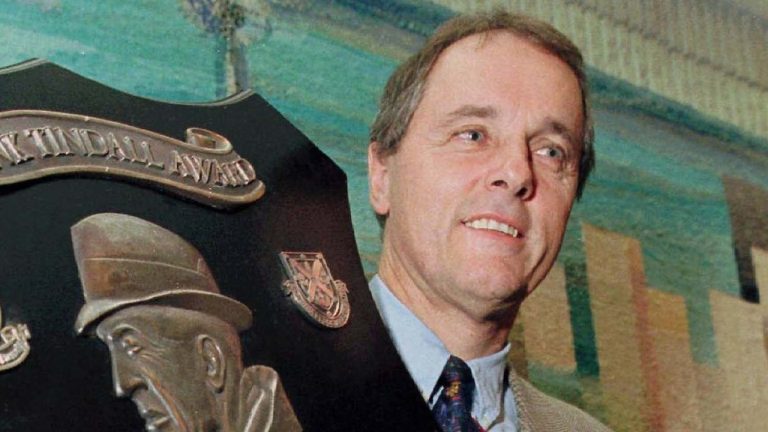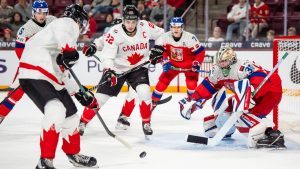Long before the days of smart phones and call display, when I was a senior in high school, I got a call from a 519-area code. I questioned whether I should pick it up or let it ride and go to voicemail. I answered and, on the other end, was a man with a twang in his voice that I’d never heard before and couldn’t exactly pinpoint geographically.
That’s because it was a former Prairie boy calling from London, Ontario: Larry Haylor, leader of the Western Mustangs. Neither of us knew at the time that the man calling me was a future Canadian Football Hall-of-Famer, and that this would be the first of many life-altering conversations I’d have with him.
Western reached out relatively late in the recruiting process, as I had only received an aggressive push from them after I was OFSAA bowl co-MVP with my St. Andrew’s College teammate, Michael Faulds. Because of that, I was jaded and wasn’t initially buying what Haylor was selling. He seemed too smooth. More of a Hollywood movie character of a football coach than an actual coach. Could anybody truly be that unflappable? I eventually got over my skepticism and added Western to the list of schools I’d consider because it checked all my proverbial boxes, even though they happened to have a coach that made a routine phone call seem like a political rally. It was, however, my relationship with that coach that eventually swung the pendulum in Western’s favour.
Other coaches recruiting me at the time talked with disdain about Western. All Haylor did was speak to what his program offered. Playing defence against the competition wasn’t part of his spiel, critics weren’t on his radar and talking about what other schools were lacking wasn’t part of what he did. All of that was why it was hard to tell Haylor that, although Western was my top choice in U SPORTS (called CIS at the time), I was taking my talents south to the NCAA. He was cordial and congratulatory. He vowed to keep in touch and wished me well. Less than a year later it was my 416-number calling him, telling him I was ready to come back to Canada, and this time no recruitment was needed.
Now, if that sounds like normal behaviour for a coach who has lost a teenage recruit, I can assure you it isn’t. Recruiting is a highly competitive marketplace and Haylor was self-assured enough not to take it personally. A coach I won’t name once refused to shake my hand post-game the first time I played his school after not committing. I soon learned this was typical behaviour for him – treating all players who didn’t commit to his program the same way.
Though it may seem like Haylor and I were cool, it wasn’t always smooth sailing. He was an incredibly hard man to play for. With time away from being a student-athlete, I now realize he was an even harder man for his staff to coach for. He was demanding and confrontational. He was a perfectionist and unrelenting. He would bark in your face and cut you open with his eyes. Simply put, playing for him was not for everyone. You had to be a certain breed, but if you were, you would come out the other end tougher and more durable — and, most importantly, well-loved. Because as critical as he was, he was also the first to congratulate.
Today, what is shockingly sobering is that I’ll never be able to have one of those conversations with Coach Haylor again.
Haylor passed away due to a sudden heart attack on Jan. 6 at the age of 76, two days after fellow iconic Mustangs coach, professor and athletic director Darwin Semotiuk passed away. The two are likely drawing up plays together in heaven.
Early in my tenure as a Mustang I found myself in his office often, asking him in great detail what I needed to do to get higher on the depth chart. I didn’t always get the answer I wanted, and I didn’t always agree with his methodology, but I always respected him because winning was his chief priority. No hidden agenda, no ambiguity. His loyalty was to the scoreboard alone.
That’s not to say he put his morals on pause to field the best possible team he could. Disciplinary actions were dealt with swiftly. During his tenure, there were very few legal or ethical transgressions. No cheating or testing scandals. No academic fraud. In comparison to the void of leadership we’ve seen in sport back then and now, his ability to steward players from all different backgrounds into productive citizens in the greater community without compromising his team’s competitiveness might be his greatest accomplishment.
There are so many fond memories I have of playing for the man my class affectionately dubbed with the ironic moniker of “L-Doggie”.
His handwritten ready sheets and cursive penmanship, his lambasting of sideline officials, the Gatorade bath we gave him when he became the all-time winningest coach in 2006, the liquid messing up his hair just in time for us to put his ball cap backwards for the photo-ops.
Despite being a bitter rival, Haylor was revered by his peers. At East-West Bowls, there was always a flock of other coaches around him, soaking up his football knowledge.
That’s because he had forgotten more about football than most will ever know.
In 1975, he started at Western as the hot-shot offensive assistant to Darwin Semotiuk, rocking a handlebar moustache while being the face of the Wing T offence in Canada. By the time he left in 2006, he was gashing teams with a zone read, spread scheme, no longer with hair on his face but with time acquiring a few greys in his hair along the way. Although strong in his convictions he was always adaptable and cutting edge — no matter the era he was in or team at his disposal.
All this while being one of the last coaches in Canada where coaching football wasn’t his only focus. Long after it was commonplace for others to do so, Haylor continued on with his duties as an assistant professor of Kinesiology, marking term papers in between advanced scouting tape. The kids he had an influence on weren’t just the ones on campus with shoulders pads and helmets. Quite frankly, his impact wasn’t contained to just his own campus.
During his final season, his tour of the league felt more like a royal procession than it did a football competition. How many schools honour an opposing coach with ceremonial kick-offs and gifts before the first snap? The tour de force of appreciation may have been respect or it may have been the appreciation that they’d no longer have to play against him. Likely, it was both.
Post-game, generally, the players line up and shake hands and the coaching staffs form a separate line to shake hands. With Haylor it was the first and only time I’ve ever seen active players on opposing teams skip the sportsmanship routine with the players they competed against because they wanted to go out of their way to show love to a coach who didn’t coach them.
Pre-game ceremonies were far from foreign to him. After setting the record for all-time wins at 154, the ceremony took so long it delayed the corresponding game — not because people were exalting Haylor, but because he spent time hugging and addressing all of his family members on the field to communicate to them; they were part of the accomplishment. That love was for his wife, Judy, who deserves as much credit for the wins and rings as he does, his sons Jordan and Matthew, who played for him at Western and daughter, Jennifer, who he cheered for from the stands arguably harder than he did for his own team as she was a standout Western basketball player.
After Haylor’s last-ever game, a semi-final loss to Laurier, Haylor was the recipient of the praise. Duane Forde interviewed him and he was nearly brought to tears on air. This from a man I didn’t even know had tear ducts. That’s how the toughest of men feel about the toughest of coaches. It’s moments like that which truly illustrate what Haylor meant to his players.
It’s not the film sessions or the on-field instruction that stick with me. Not the relaying of his play calls — which often changed three times before I reached the huddle. It’s his character best demonstrated by two quotes in particular.
The first quote he loved to put on our game-day itinerary, and recite by memory in his final address to the team Friday night after walk-through:
“It’s not the critic who counts. It’s not the man who points out how the strong man stumbled. Credit belongs to the man who really was in the arena, his face marred by dust, sweat, and blood, who strives valiantly, who errs to come short and short again, because there is no effort without error and shortcoming. It is the man who actually strives to do the deeds, who knows the great enthusiasm and knows the great devotion, who spends himself on a worthy cause, who at best, knows in the end the triumph of great achievement. And, who at worst, if he fails, at least fails while daring greatly, so that his place shall never be with those cold and cruel souls who know neither victory nor defeat.”
Nothing like Theodore Roosevelt to get you fired up for a football game. I doubt it made an impact on how any of us played that weekend, but I can certainly say it impacted how we view life. Football wasn’t the only game Haylor was concerned with us winning.
The other was very simply, “Dare to be great”. It was on the sign that every Mustang player touches as he leaves the locker room.
Haylor wasn’t concerned with public perception. He wasn’t concerned with his outward image. He wore a hand-knitted Western toque on the sidelines rather than the Adidas team issued version because he appreciated the sentiment that a loved one took the time to make it for him. He didn’t care what referees thought of him. He didn’t care what other programs were doing. He didn’t bother to make baseless claims to recruits. He cared about striving to be great and was willing to do what he thought was right in his pursuit. He’d rather dare to be great and fail than not endeavour to be great at all. What he created is a culture where everyone he touched felt comfortable being uncomfortable enough to push for greatness in all aspects of life.
It’s a sentiment I reference often in my post-playing career and keep in mind in my interpersonal relationships and professional career. He’s my unintentional broadcast coach, as I use his mentality to approach the pressure-packed profession I chose post-football. Haylor is among the Mount Rushmore of men who have left a lasting impression on me. The outpouring of tributes from his former players, coaches and even media members since his passing showcase that sentiment is not unique to me.
Learned so much from this man – Love you Coach! RIP https://t.co/hlEwlF5bTA
— Michael Faulds (@MichaelFaulds) January 7, 2022
Haylor always joked with me when I left his office, saying, “DJ, forget football. You should be an investment banker and just sit back and watch your money grow.” I laughed because I knew that wasn’t in the cards — math wasn’t my forte. But I can do simple math and it’s obvious to me what Haylor’s legacy adds up to.
In a football context the numbers don’t lie. Haylor produced two Hec Crighton award winners, 42 first team all-Canadians and saw 58 players drafted to play professionally. But, in the end, it’s not the eight Yates Cups or two Vanier titles; not the 178 wins and seven OUA Coach of the Year awards.
It’s the investment he’s made in the game of football and how well into retirement he can take solace in seeing that grow.
That impact has manifested itself in boundless ways.
Such a dreamer and a missionary for the game, he not only taught football workshops abroad he also brought his team for exhibition play in Japan. Focused on the game’s growth in Canada, in retirement he developed a national coaching program for Football Canada and even coached the national team.
During and even well after his career he could turn on a CFL game any given night and see a player or coach he’s impacted. And there is a good chance the game was broadcasted by Duane Forde or Pierre Vercheval, two men who know doubt, like I, see the game through his eyes.
He has impacted the chain of amateur coaches, too, including two of the best in the country, Greg Marshall and Michael Faulds. Haylor facsimiles in their own ways. Watching Faulds pace the sidelines back and forth, arms folded evokes memories of Haylor. Seeing Marshall be both a teacher and a therapist to his quarterbacks is textbook Haylor.
Marshall once told me that, after following in Haylor’s footsteps at Western, his job was to pick up the flag and continue to carry it up the hill. The most recent Vanier Cup champions ran the ball well, turned it over defensively and above all were an assignment correct, smart group. Larry Haylor Style Football is still being played and is still winning football long after he’s left the sidelines.
Haylor dared to be great. Even at the end of his life, he still showed great energy and ingenuity in all he did. However, the wins at this point were perfecting his golf game and spending the same level of intentionality with his six granddaughters. After all those years, his passion burned brighter than ever.
He was a ground-breaker as the first modern-day collegiate coach elected to the Hall, trailblazing the path for others to follow.
He was a vanguard.
He never had a losing season.
Now that he’s gone, the entire football community in Canada is at a loss.
But he’d want us to celebrate the wins. Cheers to coach Haylor I’m so thankful I answered your call.
[relatedlinks]





